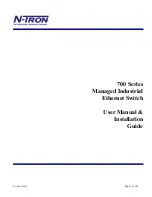
Quickstart
Gathering configuration information
MAX 4000 Series Hardware Installation Guide
Preliminary November 4, 1998
3-5
Table 3-1. T1 line configuration information
Parameters
Your setting
Comments
Sig Mode
Enter the type of signaling your line uses:
inband, ISDN, or ISDN_NFAS.
Get this information from your service
provider.
Rob Ctl
For every line using inband signaling, enter the
robbed-bit call control mechanism. Get this
information from your service provider.
Switch Type
For each line using ISDN signaling, enter the
type of switch that provides the ISDN service.
In a Net/T1 profile, specify one of the
following values:
•
AT&T—the default
•
NT1—Northern Telecommunications, Inc.
•
Japan
•
GloBanD—Q.931W GloBanD data
service
Although GloBanD can appear in the list
of switch types available under ISDN, it is
currently not supported on any T1/PRI
switches in the U.S. However, some T1/
PRI switches do support MultiRate, which
is a service like GloBanD that enables data
service bandwidths higher than 64 Kbps.
Contact your T1/PRI service provider for
specific information.
•
NI-2—National ISDN-2
Framing Mode
For each line, enter D4 or ESF. Get this
information from your service provider.
Encoding
For each line, enter AMI or B8ZS. Get this
information from your service provider.
FDL
For each line using ISDN signaling, enter the
Facilities Data Link (FDL) protocol the MAX
uses. Get this information from your service
provider.
Length
If your MAX does not have an internal CSU,
enter the cable length from the CSU or other
network interface to the MAX.
















































